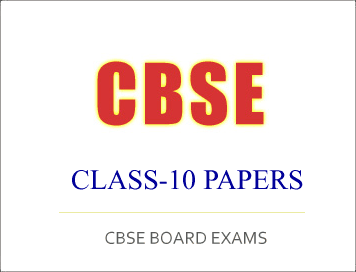(Download) CBSE Class-10 Sample Paper And Marking Scheme 2017-18 : Science
Disclaimer: This website is NOT associated with CBSE, for official website of CBSE visit - www.cbse.gov.in

CBSE CLASS-10 Sample Question Paper 2017-18
(Science)
Time allowed: 03 Hours
Maximum Marks: 80
SECTION – A
1. Give an example of a flower which contains both stamens and carpels. 1
2. Mention any one point of difference between Pepsin and Trypsin. 1
3. An element “X” has mass number 35 and the number of neutrons, is 18. Identify the group number and period of “X”. 2
4. An object of height 1.2m is placed before a concave mirror of focal length 20cm so that a real image is formed at a distance of 60cm from it. Find the position of an object. What will be the height of the image formed? 2
5. Why is there a need to harness non-conventional sources of energy? Give two main reasons. 2
6. Name the electric device that converts mechanical energy into electrical energy. Draw the labelled diagram and explain the principle involved in this device.
OR
i) What is the function of earth wire in electrical instruments?
ii) Explain what is short circuiting an electric supply.
iii) What is the usual current rating of the fuse wire in the line to feed
(a) Lights and fans?
(b) Appliances of 2kW or more power? 3
7. Draw a circuit diagram of an electric circuit containing a cell, a key , an ammeter , a resistor of 4Ω in series with a combination of two resistors (8Ω each) in parallel and a voltmeter across parallel combination. Each of them dissipate maximum energy and can withstand a maximum power of 16W without melting. Find the maximum current that can flow through the three resistors. 3
8. In the electrolysis of water,
a) Name the gas collected at anode and cathode
b) Why is the volume of gas collected at one electrode double than the other?
c) What would happen if dil H2SO4 is not added to water? 3
9. Differentiate between the arrangement of elements in Mendeleev’s periodic table and Modern periodic table. 3
10 Explain the ways in which glucose is broken down in absence of oxygen.
OR
List three differences between arteries and veins. 3
11 How do Mendel’s experiments show that traits may be dominant or recessive? 3
12 Rohit focused the image of a candle flame on a white screen using a convex lens.
He noted down the position of the candle , screen and lens as under : Position of candle = 26.0 cm
Position of convex lens = 50.0 cm
Position of screen = 74.0 cm
i) What is the focal length of the convex lens?
ii) Where will the image be formed if he shifts the candle towards the lens at a position of 38 cm?
iii) Draw a ray diagram to show the formation of the image in case (ii) as said above? 3
13. “pH has a great importance in our daily life” explain by giving three examples.
OR
A compound which is prepared from gypsum has the property of hardening when mixed with a proper quantity of water. Identify the compound and write its chemical formula. Write the chemical equation for its preparation. Mention any one use of the compound. 3
14. Why are fossils considered important in the study of evolution? Explain two ways by which age of fossils can be estimated. 3
15. Our government launches campaigns to provide information about AIDS prevention, testing and treatment by putting posters, conducting radio shows and using other agencies of advertisements.
a) To which category of diseases AIDS belong? Name its causative organism. b) Which kind of value is government trying to develop in the citizens by
conducting the above kind of programs. 3
Click Here To Download Full Sample Paper
Click Here To Download Full Marking Scheme
Courtesy:CBSE